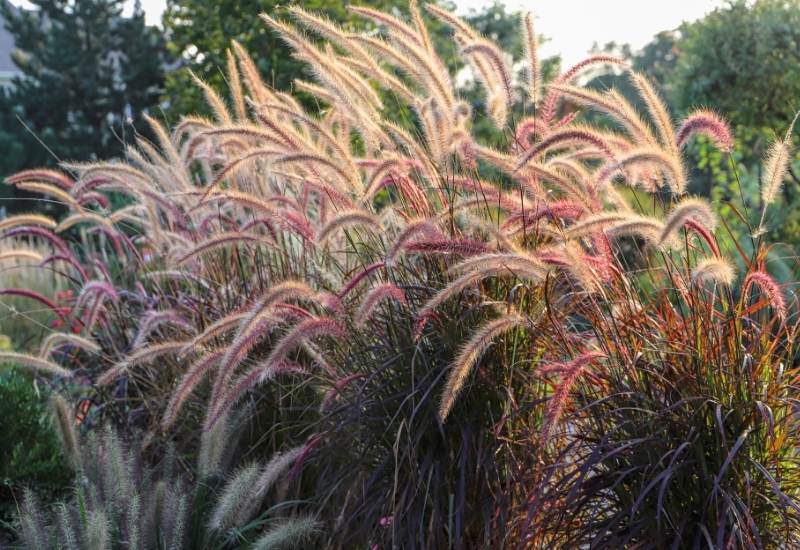
Ornamental grasses are a group of plants grown for their visual appeal. Some of the species in this group are true grasses, meaning that they belong to the Poaceae family. Others, such as sedges, are not part of this group but still exhibit grass-like qualities.
Landscape grasses offer the opportunity to fill garden spaces with interesting colors and textures that will add interest to your yard year-round. These plants are aesthetically pleasing due to their floral displays as well as their unique foliage characteristics.
Given the vast multitude of ornamental grass varieties, finding your favorite type to plant can be difficult. The first step is to know which species will grow in your region and what conditions they require.
This post will help you learn about different types of ornamental grasses and the traits which differentiate them from one another. Our list will also help you understand the growing requirements for each type ornamental grass.
Read on so that you can become familiar with some of the many ornamental grasses and pick the right one for you.
23 Stunning Ornamental Grasses To Add Color To Your Landscape All Year Long
Among ornamental grasses, there is a high amount of variation. This includes a variety of sizes, colors, and textures, as well as a variety of native ranges and ideal growing conditions.
Even within a single genus or species, there are often multiple hybrids and cultivars featuring different physical characteristics.
To find the right ornamental grass for your landscape, you need to know about the many options available to you.
Here are 23 most beautiful and easy to grow ornamental grasses for adding year-round textures to your yard:
1: Fountain Grass (Pennisetum Alopecuroides)
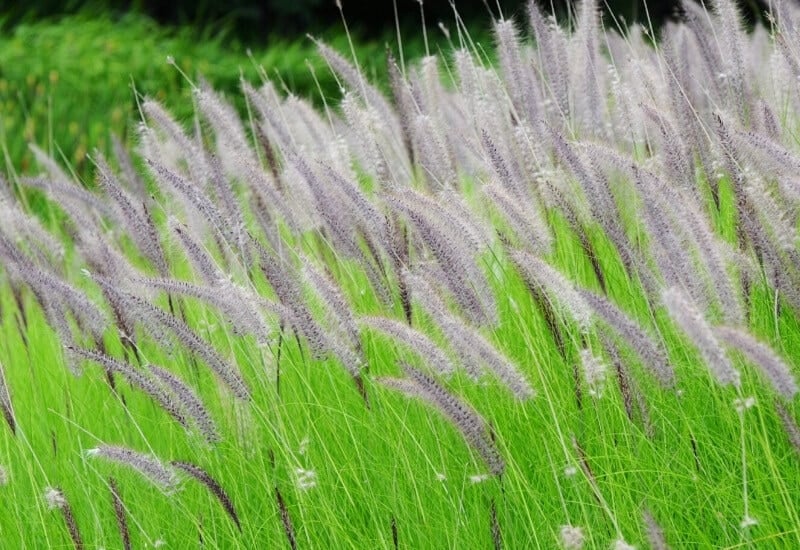
Fountain grass forms in low-growing that typically reach three feet in both height and width.
The foliage of this perennial grass slender and dark green. This color tends to fade as the summer passes by.
The most notable feature of fountain grass is its floral display. The flowers are white with a fuzzy texture. They have a spire-like shape that appears throughout the plant.
These flowers tend to persist for a long portion of the season. In the fall they start to dull their color. Then they remain on the plant into winter.
Fountain grass can grow in a variety of settings. However, it performs best in full sun. It can also survive both drought and consistently wet soils. Soils with both high and low pH are suitable as well.
When caring for fountain grass, cut it back to the ground in late winter. Do this just before the new growth appears.
2: Eulalia Grass (Miscanthus Sinensis)
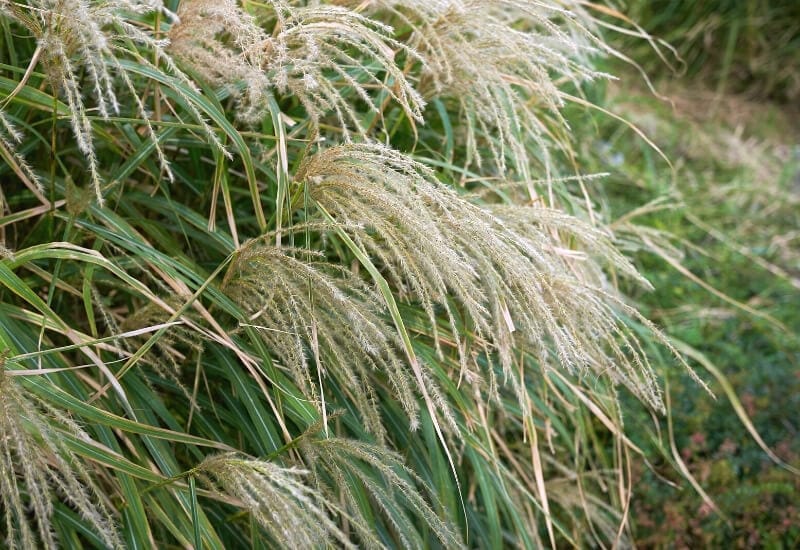
Grasses in the Miscanthus genus are typically substantial plants. In the case of eulia, its mature form consists of dense foliage frequently rising to a height of six feet.
These elongated leaves grow straight up from ground level. Then, towards the top, they begin to arch outwards.
Above this foliage are the flowers which are light and wispy. Depending on the variety, these flowers vary in color from light purple to silver and white.
Although large, individual eulia plants tend to hold their growth to a consistent area rather than in a spreading habit.
For best results, plant this ornamental grass in full sun with moist soil. Cut back to the ground in the late winter.
3: Zebra Grass (Miscanthus Sinensis ‘Zebrinus’)
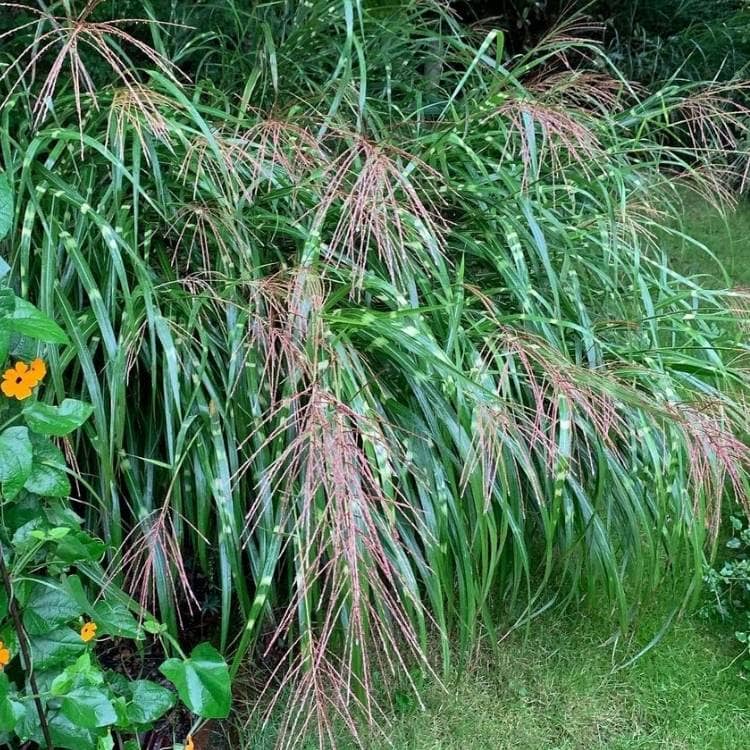
Zebra grass is a cultivar developed from the Miscanthus sinensis species. It shares many similarities with its parent, eulia. These include similar growing conditions as well as nearly identical size and form.
The difference lies in the foliage. The leaves of zebra grass are variegated. However, unlike many other variegated leaves, the color pattern of zebra grass has regularity.
Each leaf is primarily green. Bands of light yellow space themselves evenly along each leaf from root to tip. This creates a consistent stripe effect. This coloration is consistent throughout the growing season. In winter, the leaves fade to brown.
The flowers of zebra grass also fade through the season. They begin with a copper color and end as white. Regarding growing conditions, treat zebra grass the same way you would care for eulia.
4. Switch Grass (Panicum Virgatum)
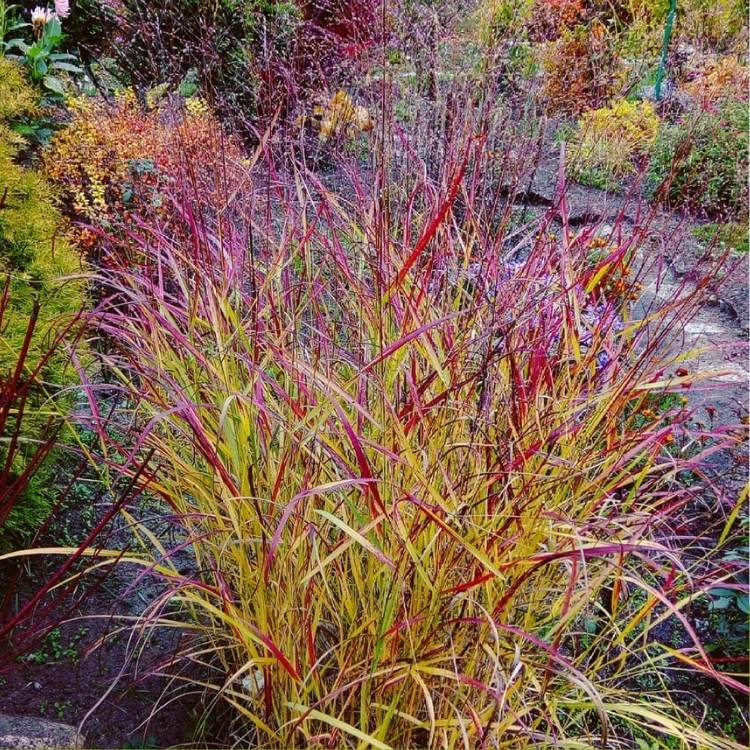
Switch grass is an ornamental grass native to the United States. It commonly grows as a prairie plant in midwestern states.
Switchgrass has a narrow form. It typically reaches fives to six feet, with a spread about half that size.
Both the flowers and leaves add a maroon accent to an otherwise green plant. The leaves are long and narrow. When touched with maroon, this coloration typically appears more than halfway up the leaf.
Switch grass flowers are individually inconspicuous. In aggregate, they create a light purple haze across the top of the plant.
This grass is adaptable to many soils. In ideal conditions, there will be moist soil in full sun. But when planted in dry or areas prone to flooding, switchgrass still survives.
5. Feather Reed Grass (Calamagrostis × Acutiflora ‘Karl Foerster’)
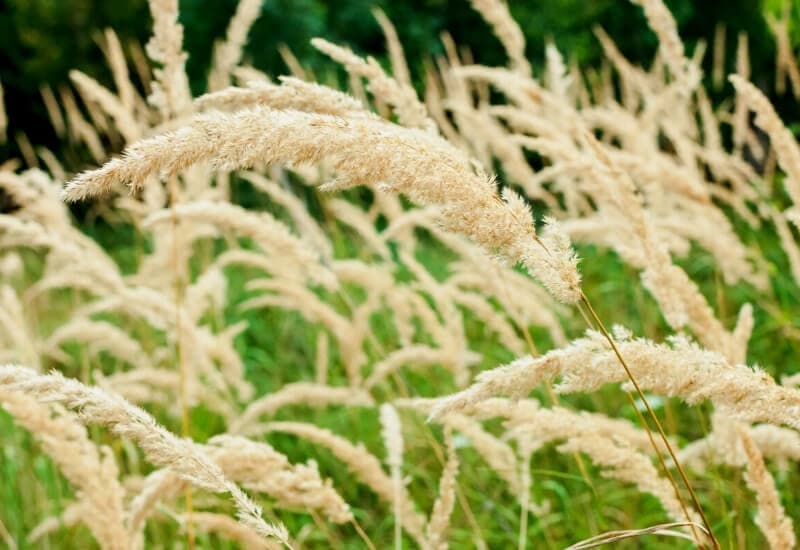
The most notable feature of feather reed grass is its flowers. These persist from spring into winter and comprise a significant portion of the plant at that time.
These flowers take the form of an elongated spike. They have a color similar to wheat. This color often darkens as the season progresses.
This grass has narrow but sharp leaves attached to rigid stalks. The overall form is narrow and cylindrical.
Feather reed grass requires full sun and prefers moist soils. It can survive in heavy clay as well.
Varieties of feather reed grass are some of the most popular ornamental grasses available in nurseries today. This is mainly due to the way feather reed grass forms spreading masses that add a pleasing texture to the landscape.
6. Blue Sedge (Carex Flacca)
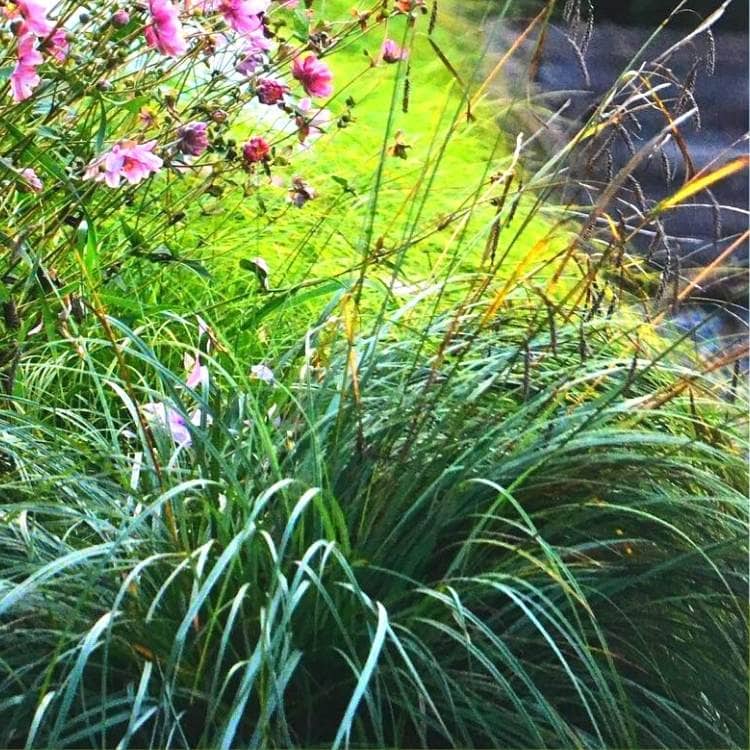
Blue sedge is a short ornamental grass variety with a round form. It often forms a small ball shape with a diameter of one and a half feet.
The leaves of this plant are extremely narrow at less than one-quarter of an inch in length. Each leaf has a distinct blue-green coloration. They grow in a dense a dense habit with a rough texture.
This odd foliage color is the main motivation for people planting blue sedge. The flowers are far from showy.
Blue sedge requires less sunlight than other ornamental grasses. It can also remain evergreen in warmer regions.
This sedge serves as a colorful groundcover. It can even withstand some foot traffic.
7. Japanese Sedge (Carex ‘Ice Dance’)
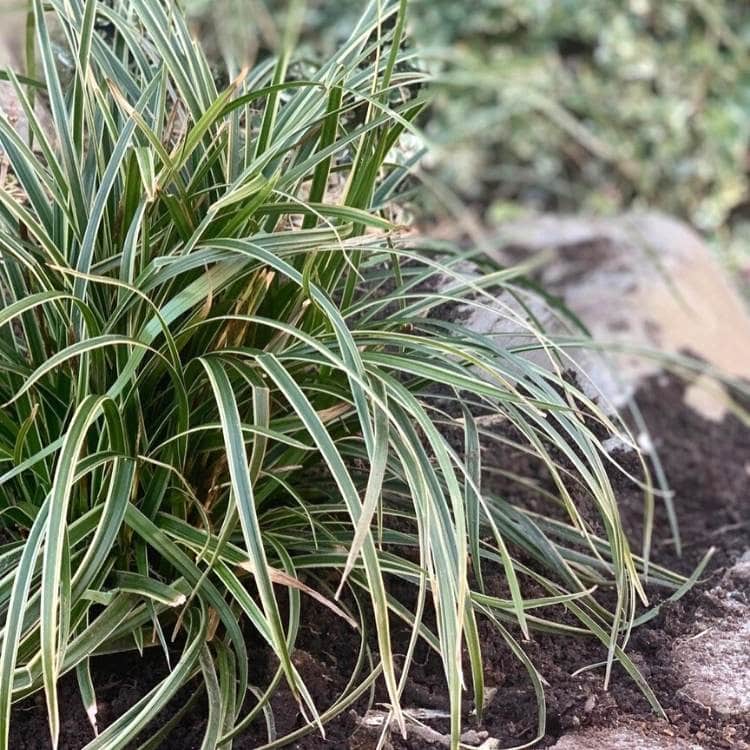
There are many sedge grass varieties, and the variety carrying the name ‘Ice Dance’ is by far one of the most attractive. This plant grows low to the ground in dense groupings of semi-evergreen foliage.
The leaves of Japanese sedge are thin and shiny. They tend to arch slightly and have a two-toned color. This includes deep green at the center of the leaf and a brilliant white color on both edges.
This foliage is the inspiration for the ‘Ice Dance’ name. It is one of the most valuable visual features of this plant as the flowers are small, brown, and hardly noticeable.
Japanese sedge is also easy to care for. This plant is pest-free, deer tolerant, and adaptable to both full sun and full shade.
8. Little Bluestem (Schizachyrium Scoparium)
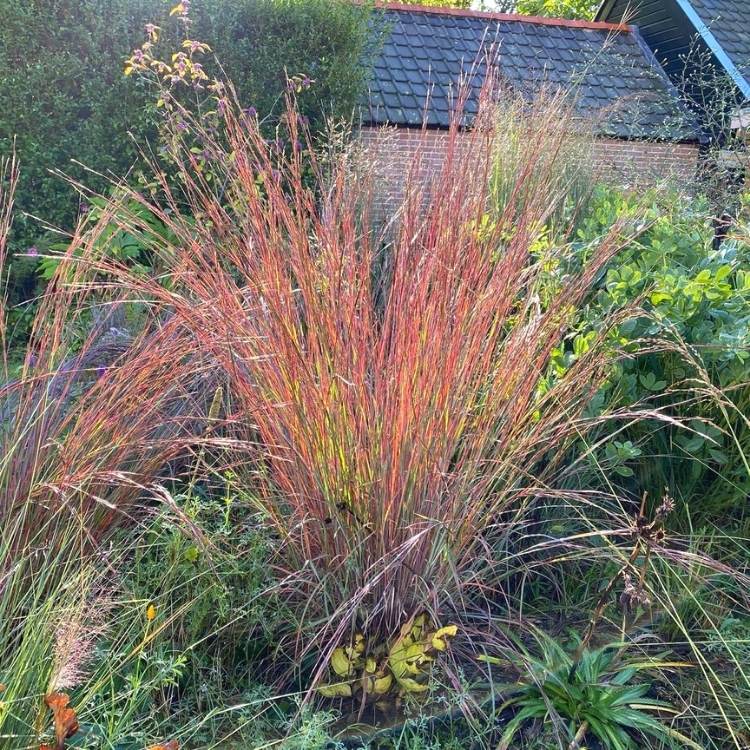
Little bluestem is a prominent prairie grass throughout North America. It has a broad native range that reaches from Canada to the American southwest.
Overall, this plant is upright and narrow in its growth habit. The leaves are narrow and often have a blue tint at their base. Otherwise, they are entirely green.
Much of the ornamental value of little bluestem lies in its flowers. The flowers are purple and three inches long. They appear in August. When they die off, a cloud of seed heads follows them.
The foliage is also known to be an attractive feature as it turns orange in the fall.
Little bluestem prefers soils that are slightly dry and slightly alkaline. However, this plant can survive in many soil types especially when it receives plenty of sun.
9. Big Bluestem (Andropogon Gerardii)
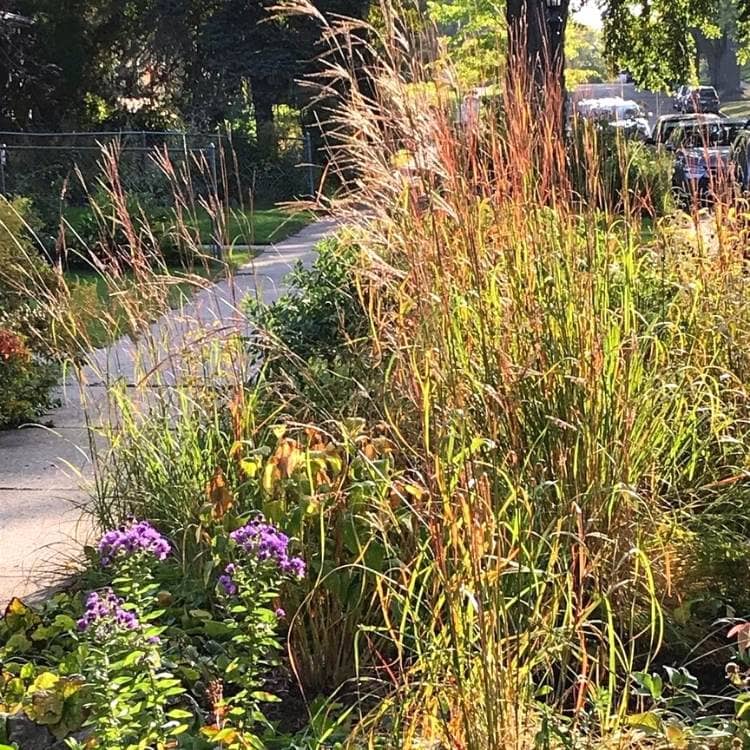
Despite similar common names, big bluestem and little bluestem are not members of the same genus. Yet, they do share some physical characteristics.
The stems of big bluestem emerge with a blue color. This color is similar to the color found year-round at the base of little bluestem leaves.
These stems hold leaves that can reach two feet in length. In fall, the foliage takes on a dark purple color. The flowers are purple as well, as they emerge in later summer.
Plant big bluestem in soils that are dry to medium moister. Full sun is ideal as well. Once established, this plant is easy to maintain. Simply cut it to the ground in late winter.
10. Blue Oat Grass (Helictotrichon Sempervirens)
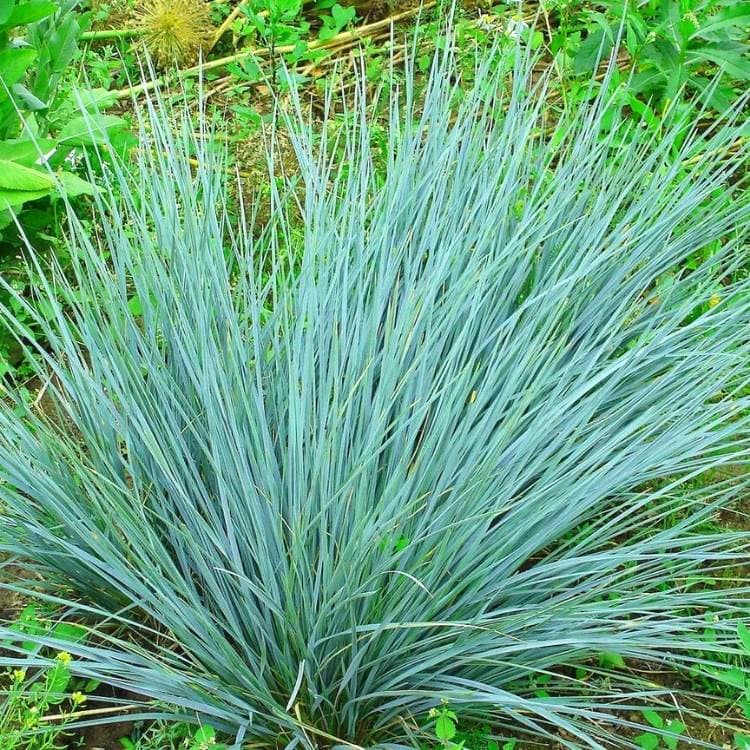
Helictotrichon sempervirens, commonly called blue oat grass grows in small rounded clumps. It is native to regions in central and southern Europe.
The foliage consists of needle-like leaves. These leaves are blue to blue-green in color.
In June, the flowers arrive. When this occurs, the height and spread of this plant can nearly double. The flowers grow like long slightly curved spikes that extend well beyond the extent of the leaves. Each flower is thin and brown with hints of blue.
Over time, some of the leaves will wither to brown. Be sure to remove these from the plant. In warm regions, this plant grows as an evergreen.
When planting blue oat grass, avoid areas with poor drainage. Planting there will lead to crown rot. Otherwise, this plant presents few issues.
11. Blue Fescue (Festuca Glauca)
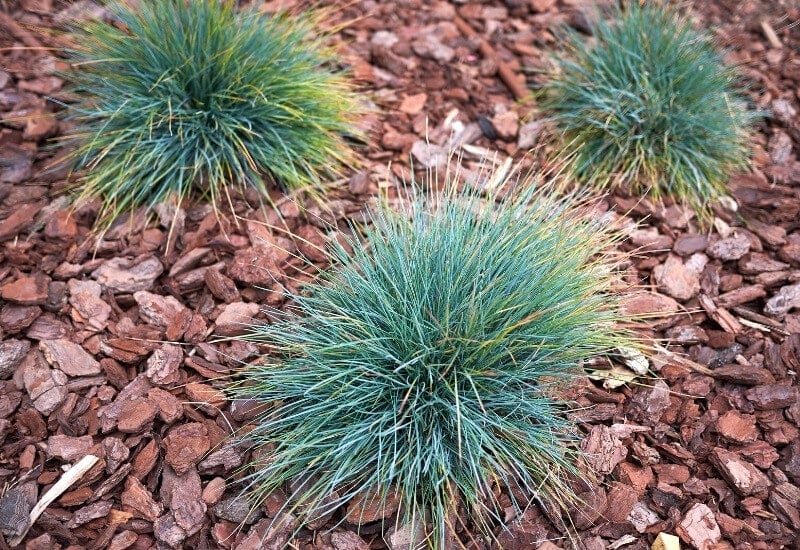
Blue fescue grass (Festuca glauca) shares similarities with blue oat grass. In some regards, blue fescue is essentially a smaller version of blue oat grass.
A prime example of this is the semi-evergreen foliage of this ornamental glass. This foliage appears in the form of sharp narrow leaves. These leaves are blue-green in color.
The flowers are wheat-like. They bloom in mid-summer as small panicles at the end of thin stalks.
The foliage color of this decorative grass is more impressive with higher sun exposure. But this doesn’t mean that blue fescue can’t survive in limited amounts of shade.
Regardless of conditions, blue fescue often has a short lifespan. While it lasts, this plant adds an interesting rough texture to any area where it grows.
12. Tufted Hair Grass (Deschampsia Cespitosa)
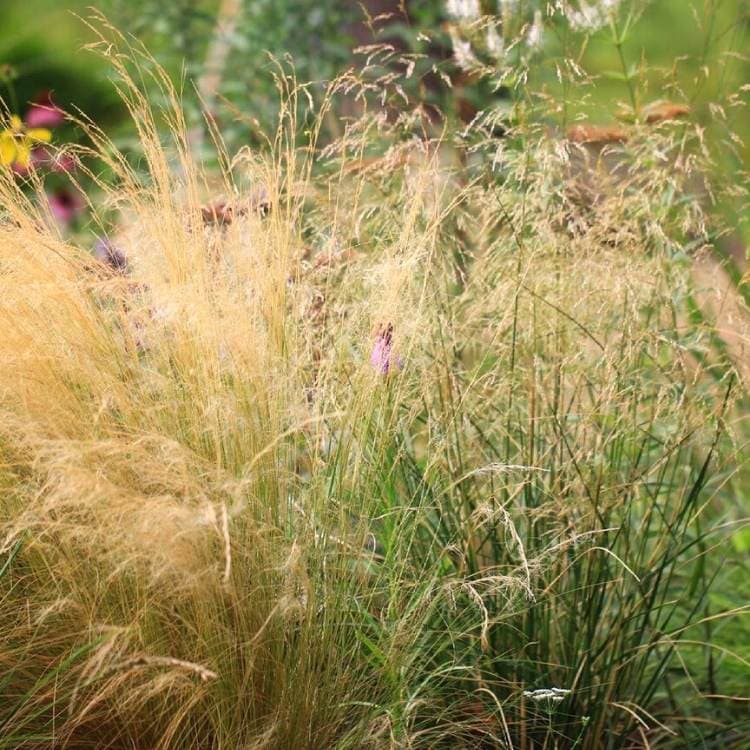
Tufted hair grass (Deschampsia cespitosa) is a small cool season ornamental grass that grows in clumps. The mature height of this plant rarely exceeds one and a half feet tall. However, in some cases, it can reach a three-foot maximum.
The leaves of tufted hair grass are a main contributor to the density of this plant. Each leaf is very narrow, but they often appear in high quantities. The leaves are also not entirely straight. Instead, they have a slight inward curl.
The flowers appear in abundance as well. This occurs in the late summer to early fall. The flower stems are long, temporarily adding to the height and spread of tufted hair grass.
The flowers themselves are light panicles. They come in a multitude of colors. These colors can include purple, silver, and gold. Later in the season, they turn a tan color.
This grass requires moist soil and partial shade. When established in the right growing conditions, this plant presents little to no maintenance needs.
13. Mexican Feathergrass (Nassella Tenuissima)
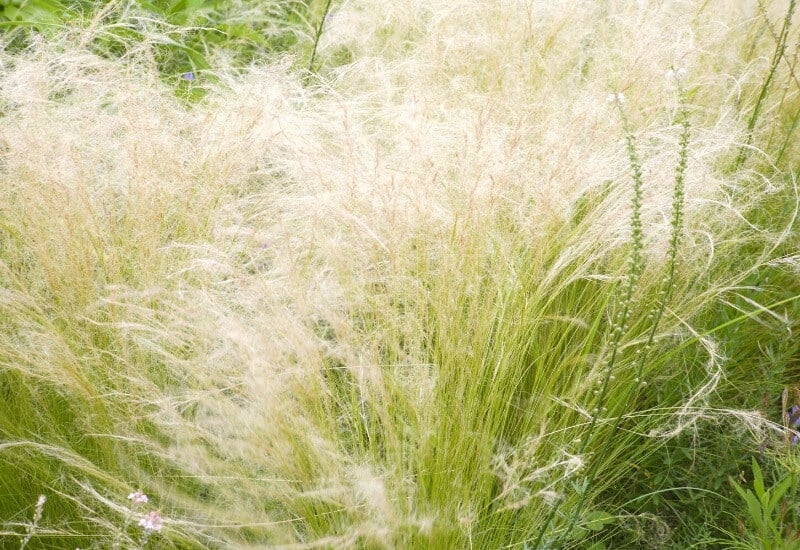
Mexican feather grass (Nassella or Stipa tenuissima) is an ornamental grass suitable for warmer regions. In that setting, its foliage often remains evergreen.
This foliage is extremely narrow and pliable. For most of the season, it is green. In Unseasonably warm summers, it can turn to a light brown.
There is no mystery as to how this plant got its common name. The flowers look just like feathers. They bloom above the foliage in late spring to early summer. They are light and a few inches long with a very light brown to white color.
Check with local authorities before planting Mexican feathergrass as some regions classify it as invasive. This is partly due to this plant’s great ability to self-seed
Mexican feathergrass is also tolerant of dry conditions and may even prefer them. In fact, too much water is a threat to this ornamental grass. When planting, choose areas of full sun and be ready to control this plant so it doesn’t spread beyond control.
14. Japanese Bloodgrass (Imperata Cylindrica)
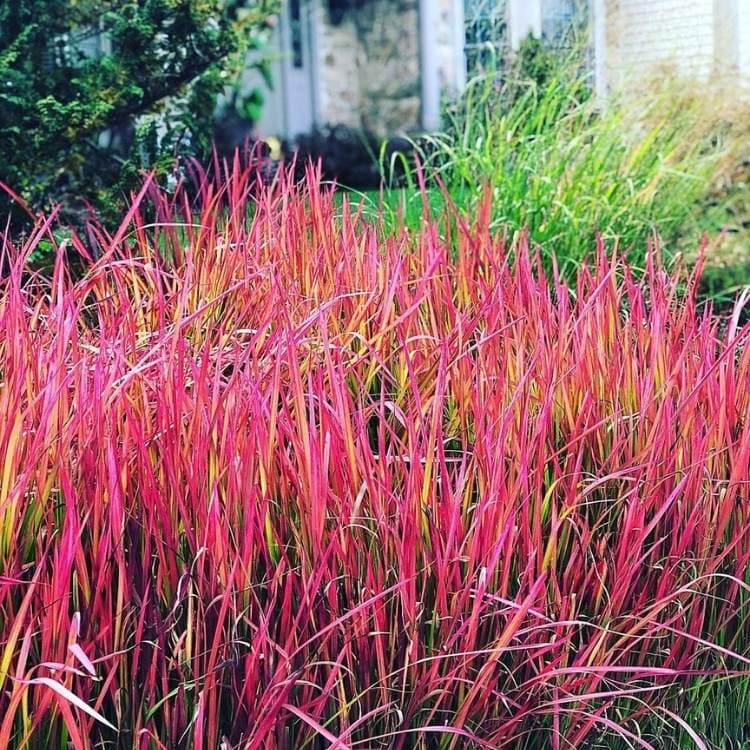
Japanese bloodgrass is an upright ornamental grass. Many varieties feature attractive two-toned foliage.
This foliage begins as green at the base. It transitions to bright red about halfway up the plant. This color tends to deepen through the season.
The flowers are secondary to the foliage in terms of visual appeal. They are thin with a silvery color and they bloom in summer.
Japanese bloodgrass is highly flammable. It burns quickly and, as a result, contributes to many wildfires.
If you choose to plant this ornamental grass to your garden, you will find that it has very few maintenance needs. Providing medium moisture soil and full sun helps to ensure this plant will be a pleasing accent in your garden.
15. Black Mondo Grass (Ophiopogon Planiscapus)
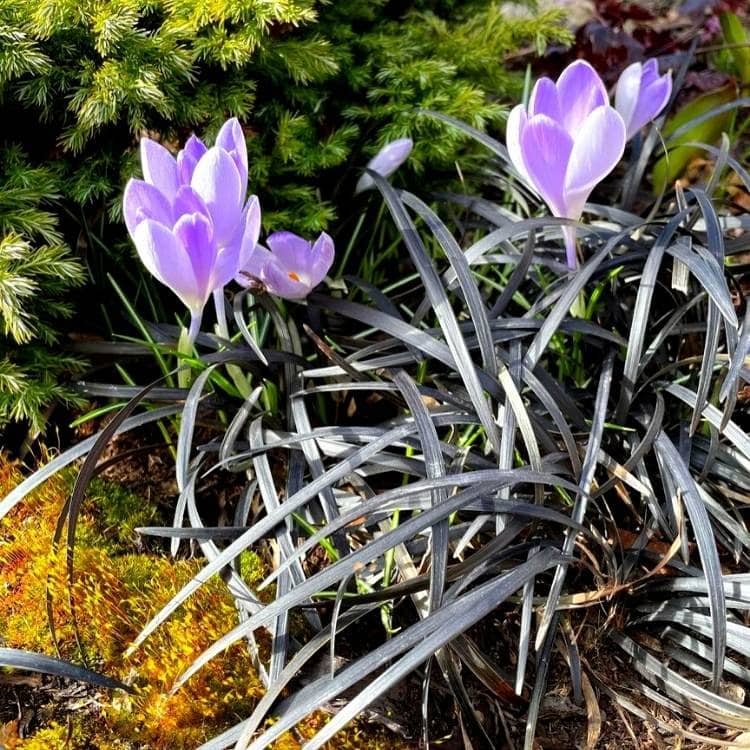
Black mondo grass is a small ornamental grass that grows best as a ground cover. The main attraction to this plant is its foliage color.
The leaves of black mondo grass are narrow and evergreen. Their margins have no serration, and they grow in a dense habit. Most notably, their color is a deep purple that nearly borders on black.
This color is constant throughout the entire year and has a lustrous appearance in the light. Other parts of black mondo grass are purple as well.
For instance, both the flowers and the fruits are typically purple as well. The fruits follow the flowers which are small and appear in mid-summer.
Black mondo grass is tolerant of many soil types including those with high amounts of salt. It also features no common diseases. For best results, find soils that are slightly acidic with medium moisture and good drainage.
16. Japanese Forest Grass (Hakonechloa Macra)
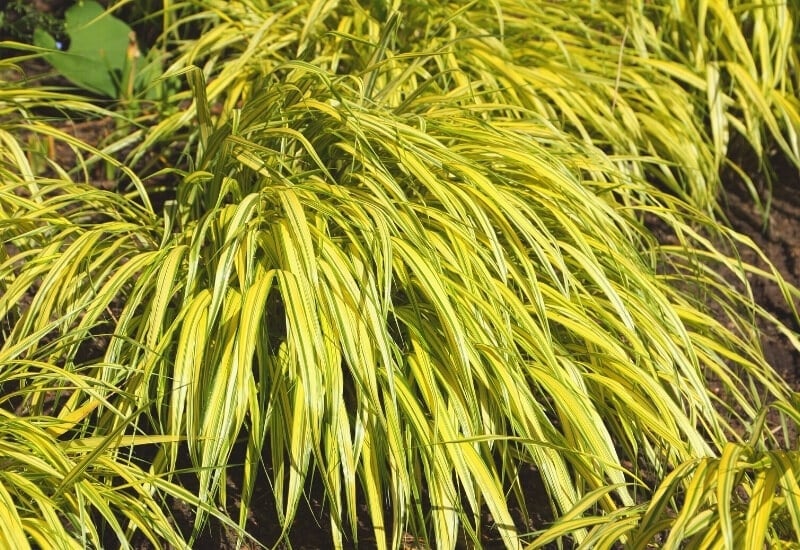
Japanese forest grass is native to East Asia and has bright green foliage. This foliage consists of sharply pointed elongated leaves. The leaves grow outward and droop downward.
In the fall, the leaves of this grass-like plant take on an orange color. Based on the variety, there can be variations on this as well as the summer color.
Unlike many ornamental grasses, Japanese forest grass prefers to be out of the full sun. Instead, part shade produces the best results for this plant.
Soil moisture is important as well. The best soil for Japanese forest grass is moist with good drainage. Organic matter and humus are also beneficial to this plant’s growth.
Provided that these conditions are met, Japanese forest grass proves to be easy to care for.
17. Gulf Muhly (Muhlenbergia Capillaris)
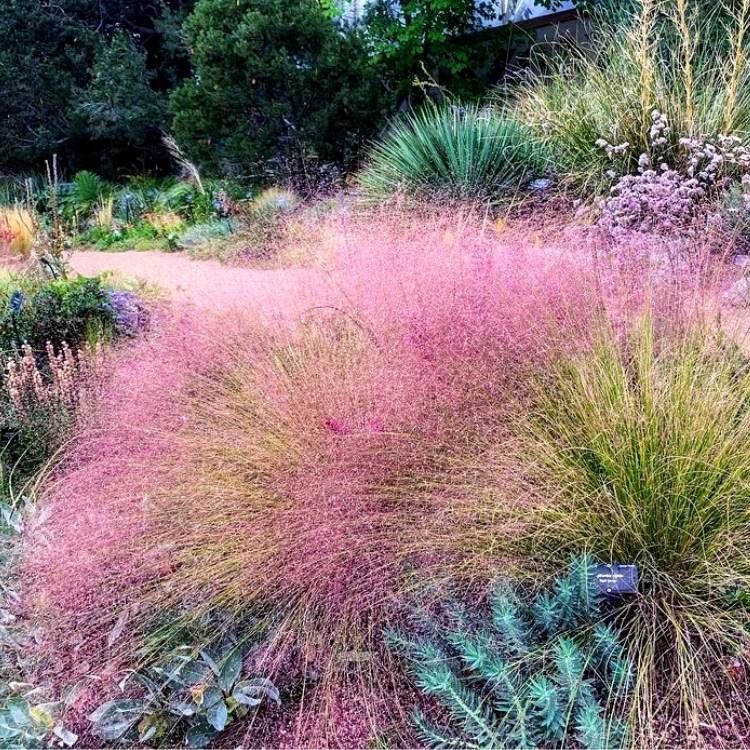
Gulf muhly is a medium-sized ornamental grass with multi-season interest. It is named for German minister and botanist Henry Muhlenberg.
Gulf muhly forms large clumps as it grows. The flowers of this plant are showy and have a major effect on the appearance of this plant when in bloom.
These flowers emerge in late summer and essentially double the size of this plant. But size is not the only significant aspect of these plants. They also have ornamental value.
The flowers are pink with a light hazy texture. When planted in masses, these flowers look like a pink mist hanging above the foliage.
The foliage is dark green and made of thin leaves. In fall they fade to a tan color.
If you live in a hot region, gulf muhly is a good ornamental grass option for you. This plant adds extraordinary texture and color to the landscape while surviving in soils with low moisture.
18. Pampas Grass (Cortaderia Selloana)
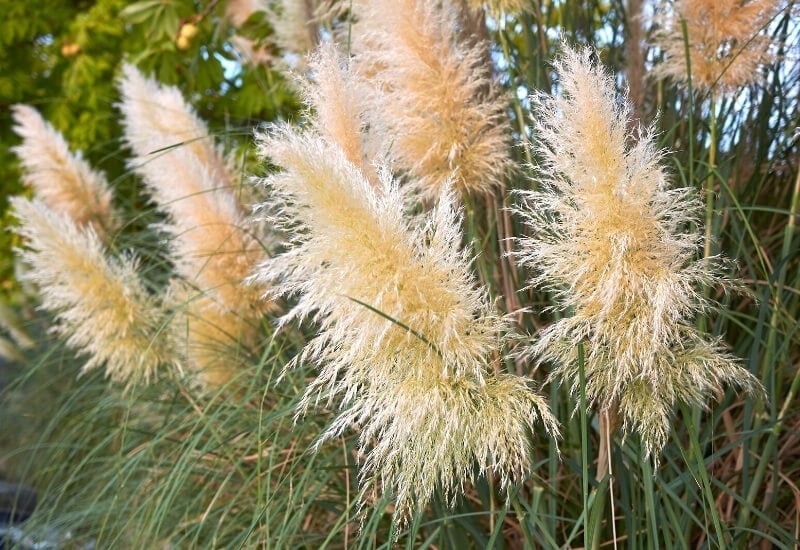
Pampas grass is one of the largest ornamental grasses around growing to ten feet at maturity. As a native of South America, this plant thrives in warmer regions.
The foliage is narrow but grows in a dense upright form. In most cases, this plant remains evergreen. This is especially true in the hotter portions of its range.
For nearly half of the season, pampas grass holds large fluffy flowers. These flowers are about six inches long and have a white to tan color.
Anyone planting this grass should know that the leaves are exceptionally sharp. This is not simply a description of the leaf shape. The margins of the leaves can truly cut like a knife.
Because of its massive size and evergreen nature, pampas grass makes for a great privacy screen. Unfortunately, this plant is considered invasive in many parts of North America.
Pampas grass spreads quickly so be responsible when deciding to plant this grass. If you live in a region where this grass is not invasive, choose a planting area with full sun. But even in part shade, pampas grass is easy to maintain and adds a large textural element to the landscape.
19. Northern Sea Oats (Chasmanthium Latifolium)
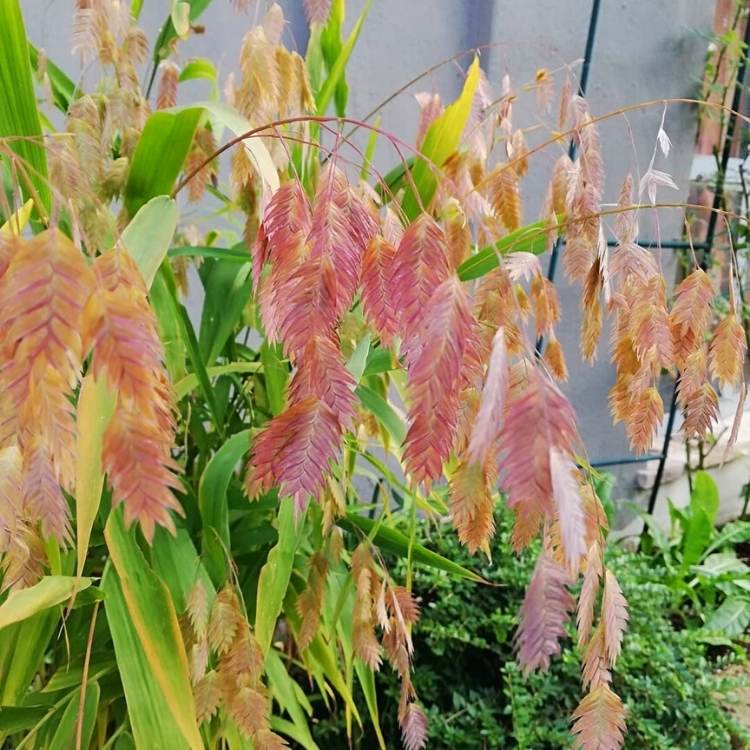
Northern sea oats is native to the eastern parts of the United States. It often grows on riverbanks and slopes in a range that reaches from the mid-Atlantic states to Florida.
The seed heads of northern sea oats are one of its most noteworthy features. These seed heads have a shape similar to oats. They dangle from the end of drooping stalks. They begin with a green color that fades to brown over time.
The leaves of this grass-like plant are long but a bit more broad than other ornamental grasses. They are attached to stiff stalks. Their color is green with hints of blue. In fall, this color transforms into a striking gold.
In keeping with the characteristics of its natural growing areas, northern sea oats needs moist soil and shade. Full sun will inhibit growth and damage the foliage.
When caring for this plant, adhere to a regular watering schedule. This is essential to helping northern sea oats thrive.
20. Prairie Dropseed (Sporobolus Heterolepis)
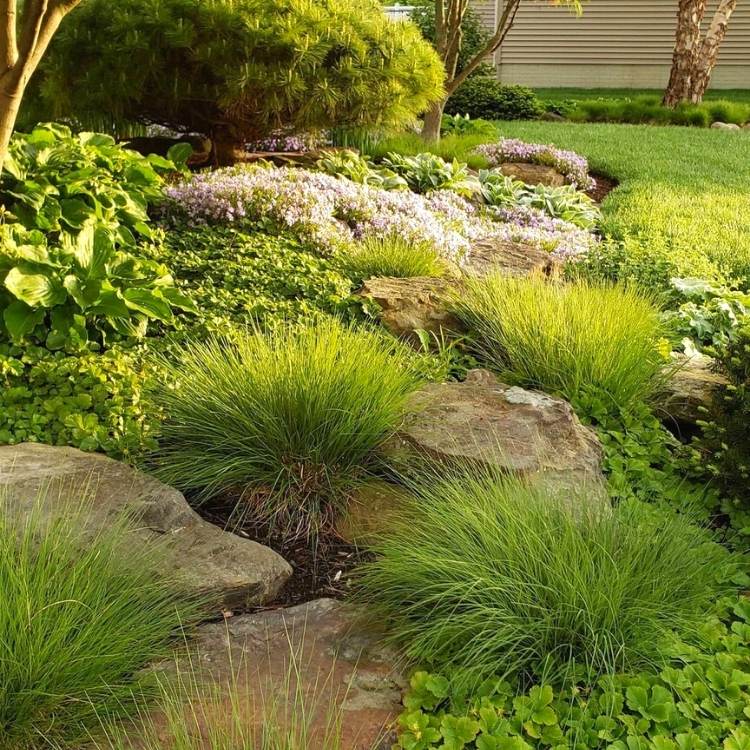
Prairie dropseed is a small native grass reaching three feet in both height and spread. It has long narrow leaves that often droop and move freely in the wind.
This ornamental grass is more valuable as a textural element than anything else. Overall, the plant maintains a consistently neutral green color.
Late in summer, the flowers appear above the leaves. These flowers are light and fuzzy with a subtle purple tint. They are also fragrant and give way to the seeds which drop to the ground every year giving this plant its common name.
Be sure to give this plant plenty of sun. Regarding soils, moisture can vary from slightly dry to slightly wet. While this plant prefers a rocky setting, clay soils are suitable as well.
In general, this plant is a reliable ground cover with few pests, diseases, and maintenance requirements.
21. New Zealand Wind Grass (Stipa Arundinacea)
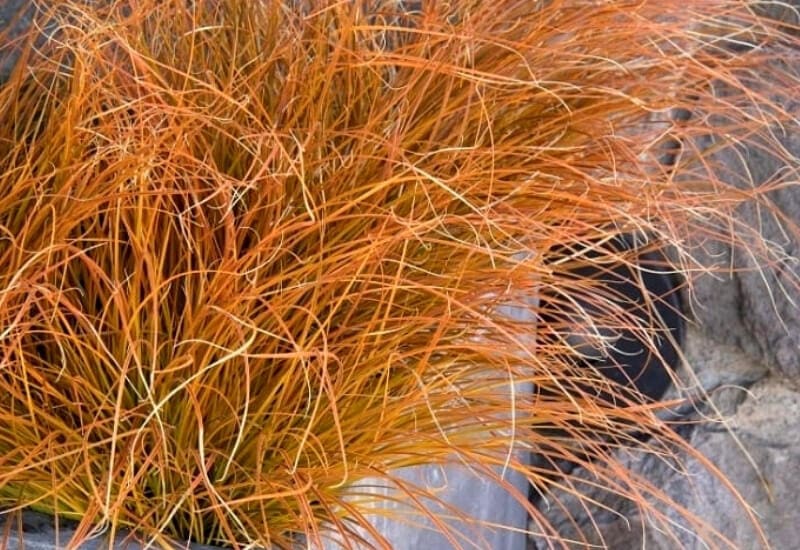
New Zealand wind grass is an enticing addition to gardens in warmer regions such as zones eight through ten. Depending on the zone, this ornamental grass can be either evergreen or semi-evergreen.
The form of New Zealand wind grass is narrow yet open. The leaves are thin and arching.
This foliage is one of the best aspects of this plant. They begin the season as green. Then they begin to turn to a bronze and tan color. The result is a two-toned array of foliage in the colder months.
New Zealand wind grass grows quickly and can adapt to many different kinds of soils. These include both dry soils and heavy clay soils.
Caring for this ornamental grass is a straightforward process. Simply remove the dead leaves in late winter. You can also choose to revitalize the growth of this plant by cutting it back to the ground. Other than this, there is little you must do to grow a healthy New Zealand wind grass.
22. Indian Grass (Sorghastrum Nutans)
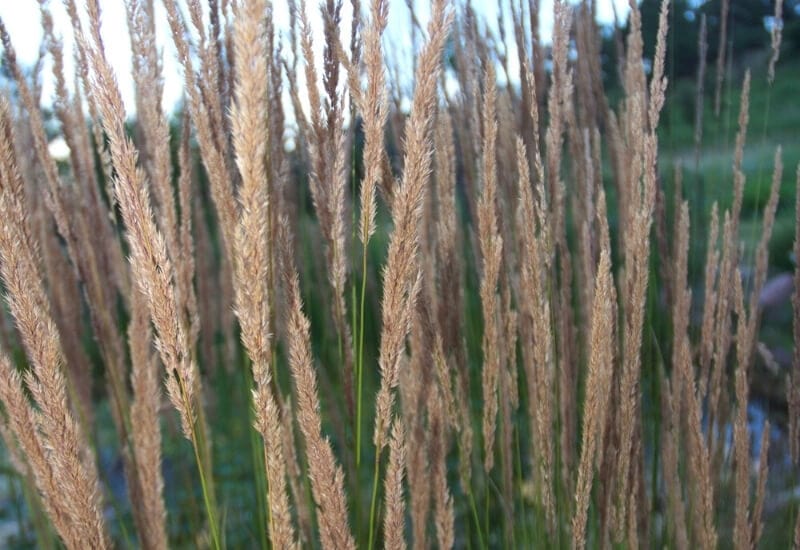
Indian grass (Sorghastrum Nutans) is one of the most cold-hardy ornamental grasses on this list. It can survive as far north as zone 2.
Its native range is evidence of this hardiness as it reaches across the northern United States and southern Canada. But indian grass grows in warm climates as well including zone 9.
The foliage is made of broad but long leaves that begin the season as green. In the fall, they have an impressive color that ranges from orange to purple.
The flowers form a loose wheat-like plume. This appears late in the growing season with a yellow to tan color.
For the best results, plant indian grass in soils with a high ph. Dry soil is preferred, but this ornamental grass can survive brief flooding as well.
23. Moor Grass (Molinia Caerulea Subsp. Arundinacea)
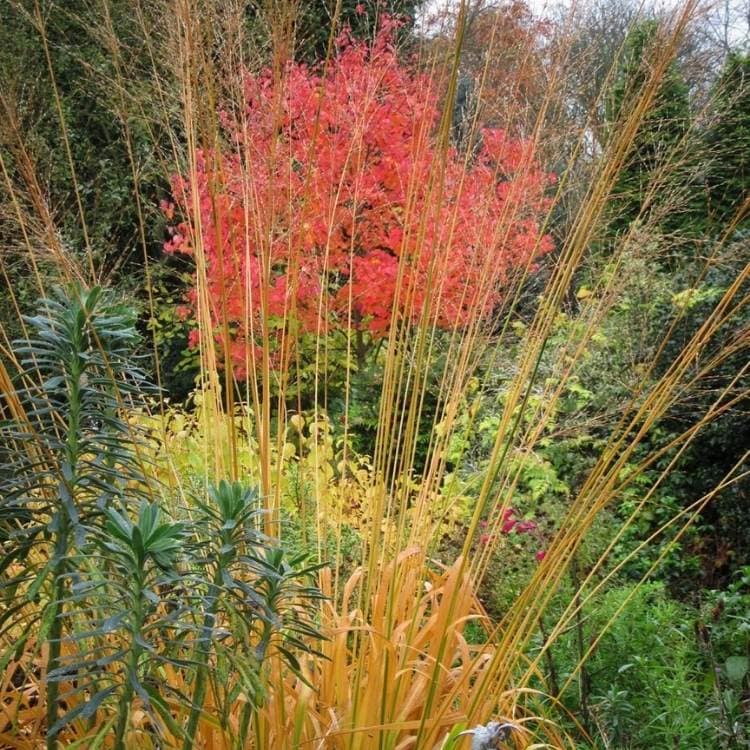
Moor grass is a tall ornamental grass variety with an interesting color change occurring in its leaves throughout the growing season. These leaves are slender and flexible.
Early in the season, the foliage is a typical green color. Then they change to purple. Finally, in the fall, they have a striking gold color.
The growth habit of this plant is upright and open. The flowers have a hazy texture and a generally dull color.
Moor grass is another example of an ornamental grass that requires little to no care. To give this plant the best chance to thrive, plant it in neutral soils that have good drainage capabilities.
Conclusion
Ornamental grasses have the potential to enhance the visual character of any landscape. These plants grow well in masses and come in many different forms.
They also often prove to have few care requirements, making them a worry-free addition to the landscape.
If you feel your yard is lacking in visual appeal, add some ornamental grasses to quickly produce a captivating textural effect.

Written By
Margie Fetchik
Margie and Arkansas native has an extensive background in gardening and landscaping. For the last 40 years, Margie has called the Colorado Rocky Mountains her home. Here she and her husband of 36 years raised three kids and owned a successful landscaping company. Margie has a CSU Master Gardener certification. She specialized in garden design & installation, perennial gardens, turf grasses & weeds, flower containers, and the overall maintenance of allHOA, commercial and residential accounts. She and her husband now reside in Denver and are excited about the new experiences’ city life holds.
